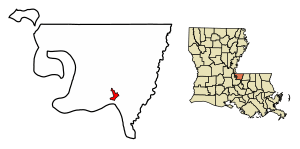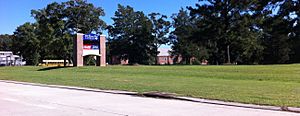St. Francisville, Louisiana facts for kids
Quick facts for kids
St. Francisville
|
|
|---|---|
|
Town
|
|
| Town of St. Francisville | |

One of several former plantation houses near St. Francisville
|
|

Location of St. Francisville in West Feliciana Parish, Louisiana.
|
|

Location of Louisiana in the United States
|
|
| Country | United States |
| State | Louisiana |
| Parish | West Feliciana |
| Established | 1807 |
| Area | |
| • Total | 1.84 sq mi (4.77 km2) |
| • Land | 1.82 sq mi (4.73 km2) |
| • Water | 0.02 sq mi (0.05 km2) |
| Elevation | 148 ft (45 m) |
| Population
(2020)
|
|
| • Total | 1,557 |
| • Density | 853.15/sq mi (329.32/km2) |
| Time zone | UTC-6 (CST) |
| • Summer (DST) | UTC-5 (CDT) |
| ZIP Code |
70775
|
| Area code(s) | 225 |
| FIPS code | 22-67215 |
| GNIS feature ID | 2407267 |
St. Francisville is a small town in Louisiana, United States. It is the main town, or parish seat, of West Feliciana Parish. In 2020, about 1,557 people lived there. It is part of the larger Baton Rouge area.
Contents
History of St. Francisville
The town of St. Francisville was started on May 11, 1807, by John H. Johnson. It was first called the Villa of St. Francis. Many old buildings from that time are still standing today. People used to call it "the town two miles long and two yards wide." This was because it was built on a narrow ridge high above the Mississippi River. It was a busy center for trade and culture for the nearby plantations.
Below St. Francisville's cliffs, there was an older settlement called Bayou Sara. French settlers started it in the early 1790s. At one time, Bayou Sara was the biggest river port between New Orleans and Memphis before the American Civil War. But floods and fires slowly destroyed it. Today, nothing is left of Bayou Sara. Some of its buildings were moved up the hill to St. Francisville in the 1920s.
Changes in Control of the Land
After the Seven Years' War in 1763, Great Britain took control of this area and other French lands east of the Mississippi River. Later, after the American Revolutionary War, Great Britain gave this land, which they called West Florida, to Spain in 1783. This was part of the Treaty of Paris.
For many years, there was an argument about where the eastern border of the Louisiana Purchase (1803) actually was. This was because France, Great Britain, and Spain had changed the borders many times in the late 1700s. Spain kept claiming land on the east side of the Mississippi River until they and the United States agreed on the border in the Pinckney Treaty. This area is now called the Florida Parishes.
St. Francisville as a Capital
In 1810, St. Francisville became the capital of the Republic of West Florida. This happened when local plantation owners removed the Spanish government from the Baton Rouge District. They created their own independent republic for 74 days. After that, it became part of the Territory of Orleans, which belonged to the United States.
In 1824, Feliciana Parish was divided into East and West. St. Francisville then became the main government center for West Feliciana Parish.
Civil War and Beyond
In June 1863, during the American Civil War, a Confederate Army officer named William Walter Leake arranged for a Union Navy officer, John E. Hart, to be buried here. Officer Hart had died on his ship during the Union's blockade of the Mississippi River. This event is remembered every June with a three-day celebration called "The Day the War Stopped."
After the Civil War, some Jewish people who were escaping religious problems in Germany came to live here. They helped the town's businesses grow during the difficult years after the war. They became successful shopkeepers, offering loans when banks failed. They also built beautiful Victorian homes, like the Wolf-Schlessinger House. Today, this house is a Bed and Breakfast called the St. Francisville Inn.
Recent Times and Tourism
In recent years, people in St. Francisville have worked hard to fix up and protect the town's old homes. St. Francisville is a popular place for tourists. Many old plantations are open for visitors to explore. These include Rosedown Plantation State Historic Site, Audubon State Historic Site, Butler Greenwood Plantation, the Myrtles, and the Cottage Plantation. There are also several beautiful gardens from before the Civil War.
In June 2011, the John James Audubon Bridge was built. This new bridge crosses the Mississippi River. It replaced a ferry that was three miles upriver. The bridge connects New Roads to St. Francisville using Louisiana Highway 10. This highway then connects to US-61, which is three miles south of St. Francisville.
In May 2011, some lower parts of St. Francisville were flooded during the Mississippi River floods.
Geography
St. Francisville covers an area of about 1.8 square miles (4.7 square kilometers). All of this area is land.
Population and People
| Historical population | |||
|---|---|---|---|
| Census | Pop. | %± | |
| 1850 | 405 | — | |
| 1880 | 721 | — | |
| 1890 | 950 | 31.8% | |
| 1900 | 1,059 | 11.5% | |
| 1910 | 966 | −8.8% | |
| 1920 | 673 | −30.3% | |
| 1930 | 830 | 23.3% | |
| 1940 | 821 | −1.1% | |
| 1950 | 936 | 14.0% | |
| 1960 | 1,661 | 77.5% | |
| 1970 | 1,603 | −3.5% | |
| 1980 | 1,471 | −8.2% | |
| 1990 | 1,700 | 15.6% | |
| 2000 | 1,712 | 0.7% | |
| 2010 | 1,765 | 3.1% | |
| 2020 | 1,557 | −11.8% | |
| U.S. Decennial Census | |||
St. Francisville first appeared in the 1850 U.S. census. At that time, 405 people lived there.
By the 2020 United States census, there were 1,557 people living in the town. There were 762 households and 395 families. Most people (about 68%) were White. About 22% were Black or African American. Other groups made up smaller percentages.
In 2000, there were 1,712 people in St. Francisville. The average household had 2.42 people, and the average family had 3.04 people. About 27% of the population was under 18 years old. The median age was 35 years. The average income for a household was $42,262.
Education

The West Feliciana Parish Public Schools system serves St. Francisville. All the public schools in the parish are located outside the town itself.
- West Feliciana High School
- West Feliciana Middle School
- Bains Elementary School (for grades 2-5)
- Bains Lower Elementary (for preschool-grade 1)
Julius Freyhan High School was the first public school in St. Francisville. It was named after Julius Freyhan, a Jewish businessman. When he died in 1904, he left money to build the school. Freyhan High was built in 1907. It was later rebuilt and served the community until the early 1950s. As of 2013, the old school building is being fixed up to become a community center and a museum.
The West Feliciana Parish Library is located in St. Francisville. In 1996, the library moved into its current building, which used to be a U.S. post office. The library became independent in January 2004.
Students in this area can also attend Baton Rouge Community College.
Sports and Recreation
The West Feliciana Sports Park is a large area of 250 acres. It is part of the West Feliciana Parish Parks and Recreation. Here, people can play baseball, basketball, soccer, softball, and tennis. There are also paths for walking, hiking, and biking. The park has a rodeo area too. The Southern Jaguars and Lady Jaguars cross country teams use this park for their home course.
Notable People
Many interesting people have connections to St. Francisville:
- Hayley Arceneaux: An astronaut who traveled to space on the SpaceX Inspiration4 mission.
- Hattie Moseley Austin: Born in St. Francisville in 1900, she founded Hattie's Chicken Shack in Saratoga Springs, New York.
- Robert H. Barrow: The 27th leader of the Marine Corps.
- Chris Broadwater: A state representative for District 86, born in St. Francisville in 1972.
- Billy Cannon: A Heisman Trophy winner for LSU football who is also a dentist in St. Francisville.
- Rod Dreher: A well-known author and journalist.
- John Rarick: A former judge and U.S. Representative who lived most of his adult life in St. Francisville.
- Albert Voorhies: The 10th Lieutenant Governor of Louisiana and a former Louisiana Supreme Court Justice, born in St. Francisville in 1829.
Images for kids
See also
 In Spanish: St. Francisville (Luisiana) para niños
In Spanish: St. Francisville (Luisiana) para niños




